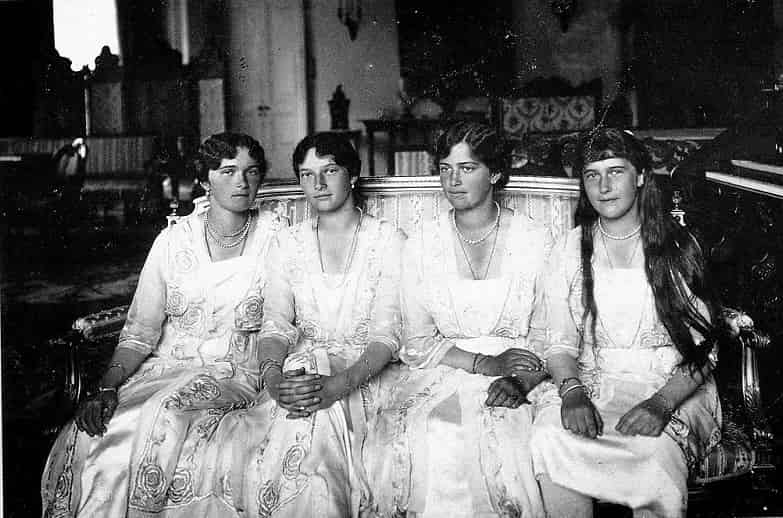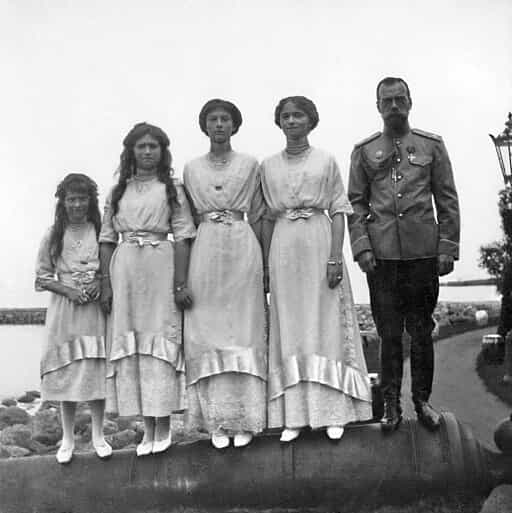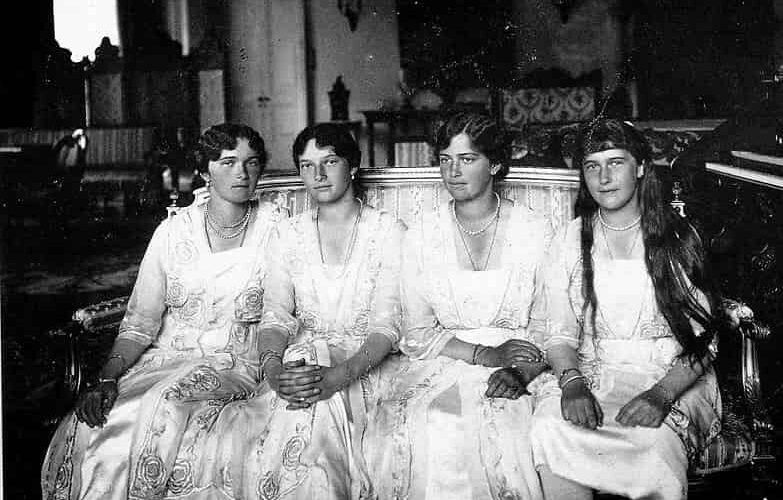The Tragic Tale of the Romanov Sisters: The Last Daughters of Imperial Russia

The Romanov sisters—Olga, Tatiana, Maria, and Anastasia—were more than just daughters of the last Tsar of Russia, Nicholas II. Their lives encapsulate the grandeur and the collapse of the Russian Empire. While they were born into unimaginable luxury, their end came in the form of brutal execution. T
his article explores the lives, personalities, and tragic fate of the Romanov sisters, shedding light on their historical significance and the enduring mysteries surrounding their deaths.
Who Were the Romanov Daughters?
The Romanov sisters, affectionately referred to as “OTMA” (an acronym formed from their first names), were the epitome of Russian imperial elegance. Each sister had a unique personality and charm that made them beloved figures both within their family and among the Russian populace.
1. Olga Nikolaevna Romanov
Born on November 15, 1895, Olga was the eldest of the sisters. Known for her introspective and serious nature, she often shouldered the burdens of being the eldest child. Olga was highly intelligent, with a keen interest in literature and poetry. Her deep emotional sensitivity and sense of duty often led her to worry about the well-being of her family.
2. Tatiana Nikolaevna Romanov
Tatiana, born on June 10, 1897, was often considered the most regal of the sisters. She was tall, elegant, and had a natural affinity for leadership. Often referred to as “the Governess,” Tatiana had a strong sense of responsibility, taking charge in various family matters and during their time as wartime nurses in World War I.
3. Maria Nikolaevna Romanov
Maria, born on June 26, 1899, was known for her warm and gentle disposition. She had a talent for connecting with people, often described as the most charming of the sisters. Maria had a particular fondness for children and dreamed of becoming a mother. Her kind-hearted nature made her a favorite among the family servants.
4. Anastasia Nikolaevna Romanov
The youngest, born on June 18, 1901, Anastasia was full of energy and known for her mischievous and playful personality. She was a natural entertainer, with a keen sense of humor and a love for practical jokes. Despite her lighthearted demeanor, Anastasia also possessed a sharp intellect and a quick wit.

What Happened to the Romanov Sisters?
The sisters’ lives were upended by the Russian Revolution of 1917, which marked the end of over 300 years of Romanov rule. After Tsar Nicholas II abdicated the throne, the Romanov family was placed under house arrest. Initially confined to the Alexander Palace, they were later moved to Tobolsk in Siberia, and finally to the Ipatiev House in Yekaterinburg.
During their captivity, the sisters maintained a close bond, supporting each other and their family through the increasingly harsh conditions. Despite their royal upbringing, they adapted to the austere lifestyle imposed by their captors, even taking on menial tasks to help sustain the family.
Why Weren’t the Romanov Sisters Married?
The Romanov sisters remained unmarried for several reasons, largely due to the political turmoil of the time. Traditionally, royal marriages were arranged for political alliances, but as World War I unfolded, such opportunities diminished. Moreover, the protective nature of their mother, Tsarina Alexandra, further limited their interactions with potential suitors.
Additionally, the family’s isolation during the war and subsequent revolution meant there were fewer opportunities for the sisters to meet and court prospective husbands. The sisters’ royal lineage, once an asset in matrimonial politics, became a liability in a world increasingly hostile to monarchy.
How Did the Romanov Sisters Die?
The tragic end came on the night of July 16-17, 1918. The Romanovs were awakened and told they were being moved to a safer location due to the advancing anti-Bolshevik forces. They were led to a basement room under the pretense of taking a photograph to prove their safety. Instead, the Bolsheviks had planned their execution.
The execution squad, led by Yakov Yurovsky, entered the room and opened fire. The chaos of the scene was amplified by the fact that the sisters had sewn jewelry into their clothing, which acted as a makeshift armor, deflecting the bullets. This led to a prolonged and horrific death as the executioners resorted to bayonets and gunshots at close range to complete the massacre.
Did the Romanov Sisters Suffer?
The Romanov sisters endured immense suffering both during their captivity and in their final moments. The physical conditions of their imprisonment were harsh, and they faced emotional anguish knowing their fate was uncertain. The brutal nature of their execution, described in graphic detail by historical accounts, underscores the immense suffering they endured.
Which Romanov Family Survived?
While the immediate family of Tsar Nicholas II did not survive, some extended members of the Romanov dynasty managed to escape the revolution. These survivors fled Russia and settled in various parts of Europe and the United States. They played a crucial role in keeping the legacy of the Romanovs alive, contributing to the preservation of Russian cultural heritage in exile.
Which Romanov Sister Was Missing?
For decades, speculation swirled around the possibility that one of the Romanov sisters—either Maria or Anastasia—had survived the execution. Numerous impostors, most notably Anna Anderson, claimed to be Anastasia. These claims were fueled by the mysterious circumstances of the Romanovs’ deaths and the initial lack of conclusive evidence.
It wasn’t until the late 20th century, with the discovery of the Romanovs’ remains and advances in DNA testing, that it was confirmed all four sisters perished alongside their family.
Why Were the Romanovs Killed?
The Romanovs were executed by the Bolsheviks as part of a broader effort to eliminate the monarchy and solidify communist control. The Bolsheviks viewed the Romanovs as symbols of the old regime, and their continued existence posed a threat to the revolution. By executing the entire family, the Bolsheviks aimed to prevent any possibility of a monarchist revival.
Were the Romanovs’ Bodies Found?
The remains of the Romanov family were discovered in two separate locations near Yekaterinburg. The first grave, containing the bodies of Nicholas II, Alexandra, and three of their daughters, was found in 1991. The second grave, discovered in 2007, held the remains of the Tsarevich Alexei and one of the sisters, believed to be Maria or Anastasia. DNA testing confirmed the identities, laying to rest the mysteries surrounding their deaths.
The Romanov sisters’ story is one of beauty, resilience, and tragedy. Their lives, marked by privilege and cut short by the chaos of revolution, continue to captivate the world. The Romanovs’ fall serves as a poignant reminder of the fragility of power and the devastating human cost of political upheaval. The sisters’ legacy endures, symbolizing both the grandeur of Imperial Russia and the profound loss of its final chapter.
FAQ: The Romanov Sisters
1. Who were the Romanov sisters?
The Romanov sisters were the daughters of Tsar Nicholas II and Tsarina Alexandra of Russia. Their names were Olga, Tatiana, Maria, and Anastasia. They were the last princesses of Imperial Russia, living in luxury until their family’s downfall during the Russian Revolution.
2. What happened to the Romanov sisters?
The Romanov sisters, along with their family, were placed under house arrest after the Russian Revolution. They were eventually executed by the Bolsheviks on July 17, 1918, in the basement of the Ipatiev House in Yekaterinburg.
3. Why weren’t the Romanov sisters married?
The Romanov sisters remained unmarried due to the political instability during their adolescence, World War I, and the Russian Revolution. Additionally, their protective mother limited their exposure to potential suitors, and the collapse of the monarchy eliminated prospects for traditional royal marriages.
4. How did the Romanov sisters die?
The Romanov sisters were executed by a Bolshevik firing squad, along with their parents and younger brother Alexei. The execution was brutal, involving both gunfire and bayoneting due to the protective jewelry sewn into their clothing that initially deflected bullets.
5. Did the Romanov sisters suffer during their execution?
Yes, historical accounts indicate that the Romanov sisters suffered greatly during their execution. The initial gunfire was ineffective due to hidden jewelry, leading to a prolonged and violent death by additional gunshots and bayoneting.
6. Which Romanov family members survived?
No members of Nicholas II’s immediate family survived. However, some extended Romanov relatives managed to escape Russia during the revolution and lived in exile in various countries.
7. Was any Romanov sister missing after the execution?
For many years, rumors suggested that one of the sisters, either Maria or Anastasia, might have survived. This belief was fueled by impostors, but DNA testing confirmed that all four sisters perished alongside their family.
8. Why were the Romanovs killed?
The Romanovs were killed by the Bolsheviks to prevent any possibility of the monarchy being restored. The execution was part of a broader effort to eliminate symbols of the old regime during the Russian Revolution.
9. Were the bodies of the Romanov sisters found?
Yes, the remains of the Romanov sisters and their family were discovered in two separate graves near Yekaterinburg. DNA testing conducted in the 1990s and 2000s confirmed the identities of the remains, putting to rest many of the questions surrounding their deaths.
10. Why is the Romanov sisters’ story significant?
The Romanov sisters’ story is significant because it represents the fall of the Russian Empire and the personal human tragedy within a monumental historical event. Their lives and tragic end offer insight into the collapse of monarchies and the rise of revolutionary movements in the 20th century.

